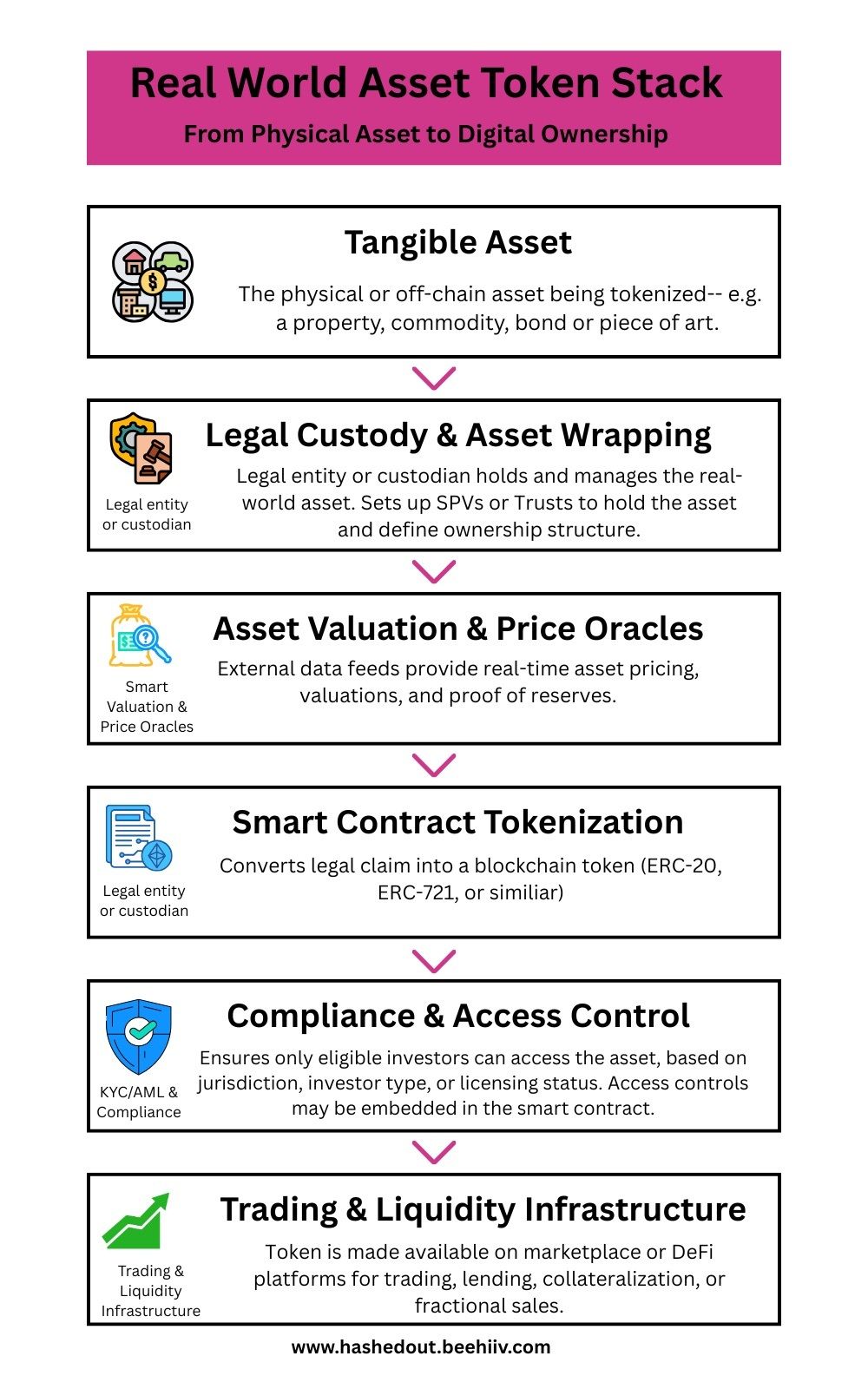- Hashed Out
- Posts
- Tokenized Real World Assets: Bridging the Digital and Physical Worlds
Tokenized Real World Assets: Bridging the Digital and Physical Worlds
How blockchain is transforming ownership, liquidity, and global access to real-world value

Introduction
Real estate. Gold. Fine art. Treasury bonds. These are tangible assets—foundations of wealth and security for generations. But for most people, they’ve remained out of reach. What if you could own a slice of a Manhattan condo, a gold bar in Singapore, or even part of a Picasso painting—without needing millions in capital or an elite financial advisor?
That’s the promise of tokenized real world assets (RWAs)—a growing movement to bring the analog world onto the blockchain.
What Are Tokenized RWAs?
In simple terms, tokenized RWAs are digital tokens that represent ownership or claims on real-world assets. These tokens live on a blockchain, but they’re backed by tangible items: property, commodities, financial instruments, or physical goods.
They make it possible to divide and distribute ownership in a programmable, liquid, and global way.
Think of it as owning a share of a building, bottle of vintage wine, or government bond—except you can store it in your crypto wallet, trade it instantly, and verify its backing on-chain.

The Evolution of Tokenized Assets
While the idea isn’t entirely new—early projects emerged during the 2017–2018 ICO boom—today’s landscape is dramatically more robust. With the rise of DeFi, clearer legal frameworks, and improved infrastructure, tokenized RWAs are gaining serious traction.
From 2020 onward, platforms like Centrifuge, Ondo, and Backed Finance began building the “plumbing” for compliant, secure tokenized assets. By 2024, even legacy institutions like BlackRock, JPMorgan, and Franklin Templeton were piloting tokenized treasury products.
Types of Assets Being Tokenized
Tokenization is being applied to a diverse set of real-world categories:
Real Estate: Fractional ownership of apartments, commercial buildings, or development projects
Commodities: Gold, silver, oil, carbon credits
Financial Instruments: Treasury bills, private credit, securitized debt
Luxury Goods: Watches, vintage wine, rare cars, fine art
Intellectual Property: Music royalties, patents, licensing rights
This isn't theoretical—there are live markets today where users can invest in these assets via tokenized instruments. As the benefits of RWAs become more widely known you can expect the range of new applications to grow exponentially.
Why Tokenize Real World Assets?
Liquidity
Many real-world assets are illiquid. Tokenization enables secondary trading on decentralized platforms.
Global Access
Anyone with an internet connection can now invest in assets previously locked away behind jurisdictional, financial, or regulatory walls.
Programmability & Automation
Smart contracts can automate dividends, rental income distribution, or royalty payments.
Transparency
Blockchain’s auditability enhances trust, especially when combined with trusted custodians and oracles.
Fractional Ownership
Investors can buy slivers of high-value assets, reducing minimum investment thresholds dramatically.
What’s the Catch? Challenges Ahead
Despite its promise, tokenized RWA adoption is not without hurdles:
Legal Uncertainty: Jurisdictional laws still lag behind the technology
Custody Risks: Someone still has to store the gold, hold the deed, or manage the property
Valuation and Pricing: Reliable data oracles and frequent appraisals are needed
UX and Interoperability: Many platforms are still clunky or siloed
As with many emerging technologies, trust will be earned over time—but the groundwork is being laid fast.
Who’s Leading the Way?
Here are some key players shaping the space:
Ondo Finance: Tokenized treasuries and yield-bearing stablecoins
Centrifuge: Decentralized credit for real-world assets
RealT: Tokenized real estate investing
Backed Finance: Tokenized securities with regulatory compliance
Maple Finance: On-chain credit for institutional borrowers
Tangible: Tokenized luxury goods
Use Cases in the Wild
Ondo’s OUSG Token: Backed by short-term U.S. treasuries—offering real-world yield to DeFi
Dubai Real Estate: Tokenized apartments for global investors
Paxos Gold (PAXG): A crypto token backed by allocated physical gold
Royal Music Rights: Artists tokenizing future royalties and revenue streams
These examples are just the beginning. We’re seeing DeFi protocols allocate treasury funds into tokenized RWAs to hedge volatility and earn yield.
Looking Ahead
Experts predict that $10–15 trillion in real-world assets could be tokenized by 2030. BlackRock CEO Larry Fink even called tokenization "the next generation for markets."
But for that vision to come true, we’ll need:
Regulatory frameworks to catch up
Interoperable standards between blockchains
More intuitive user interfaces and trusted custodians
The Bottom Line
Tokenized RWAs are more than a buzzword—they’re a fundamental shift in how we own, trade, and interact with value. By combining the security and global reach of blockchain with the tangibility of real-world assets, tokenization is unlocking new frontiers in wealth creation and participation.
We’re witnessing the early days of a transformation that could do for assets what the internet did for information.
The future of ownership is here. And it’s on-chain.Stay ahead of the curve with the latest in Web3 culture and innovation. Subscribe to Hashed Out for exclusive insights, case studies, and deep dives into the decentralized future.
Other Articles In This Issue:
